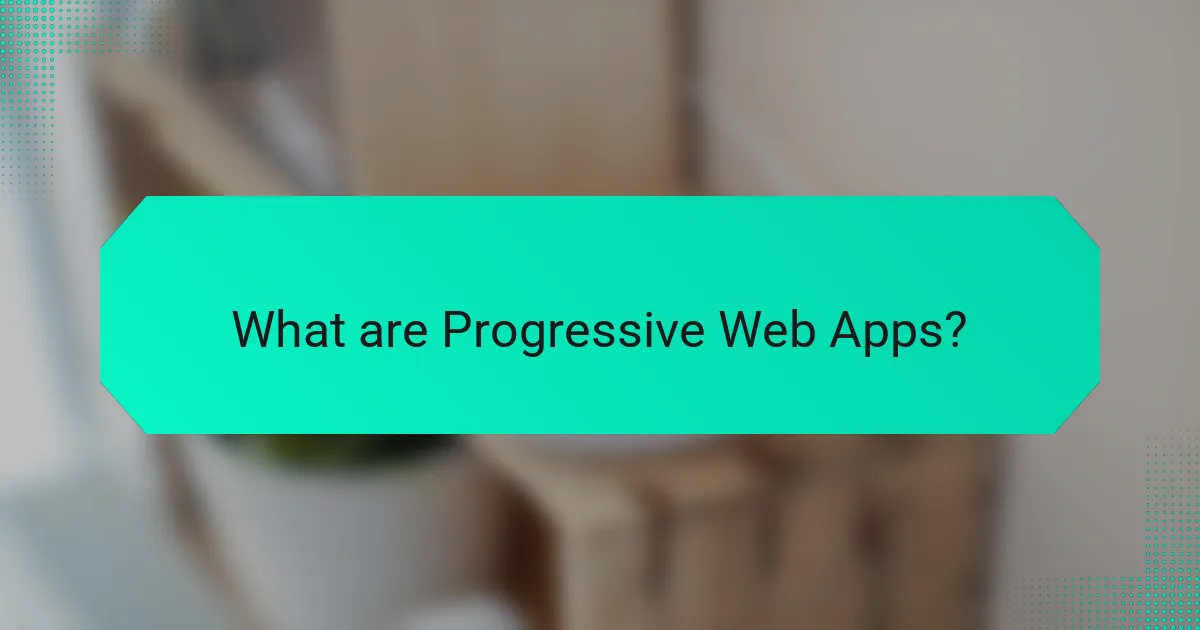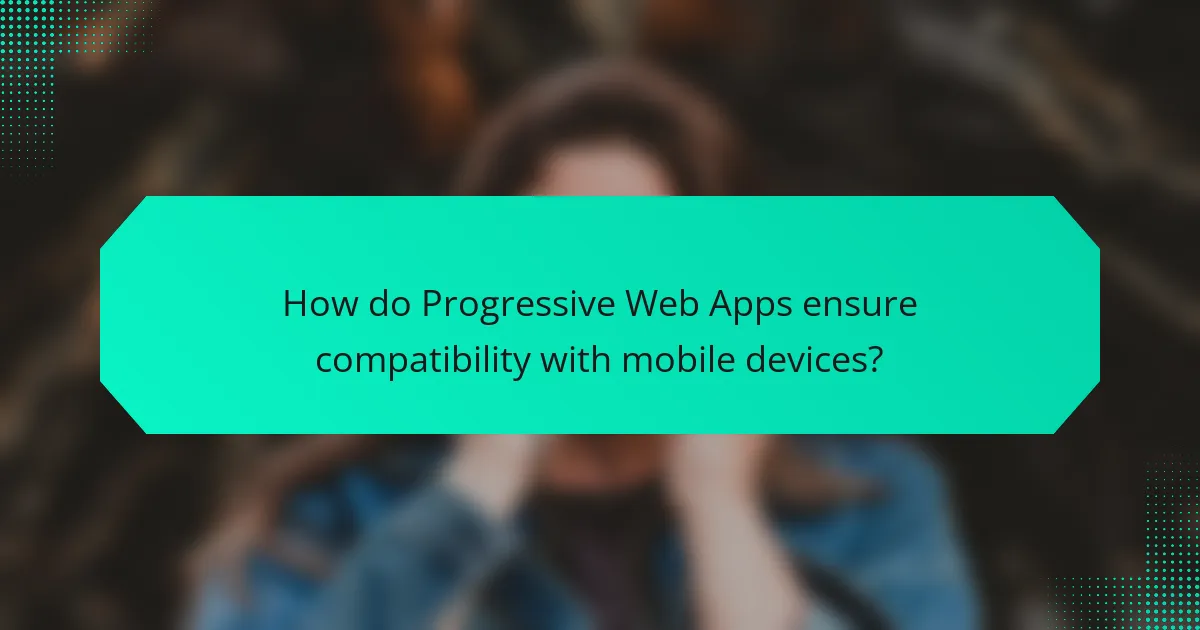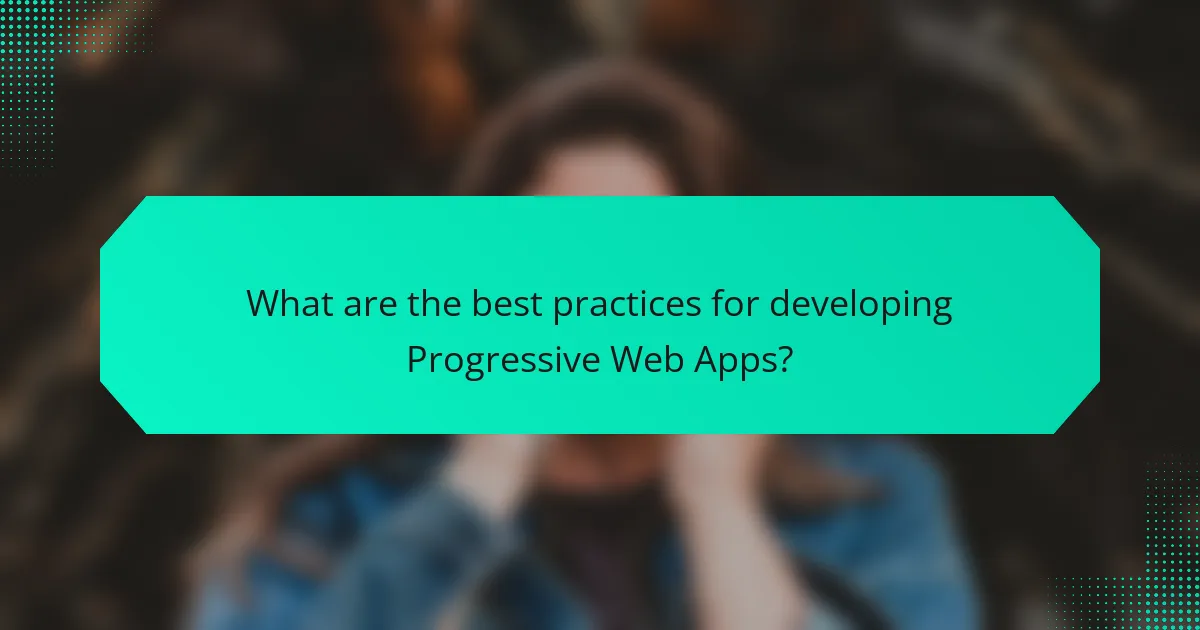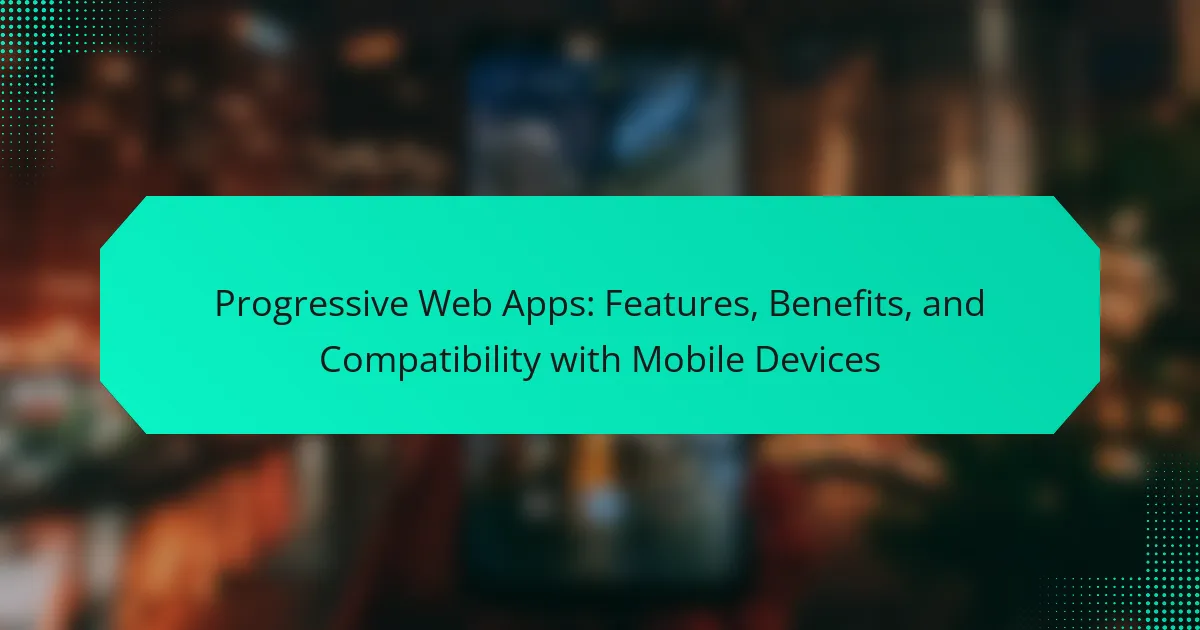Progressive Web Apps (PWAs) are web applications that leverage modern web capabilities to deliver a user experience akin to native applications. Designed for compatibility with any standards-compliant browser, PWAs can be installed on devices, function offline, and utilize service workers for efficient caching and background processes. They enhance user engagement through features like push notifications and responsive design, ensuring optimal performance across various mobile devices. Best practices for PWA development include implementing HTTPS for security, optimizing load times, and incorporating user engagement strategies, all contributing to improved user retention and satisfaction.

What are Progressive Web Apps?
Progressive Web Apps (PWAs) are web applications that utilize modern web capabilities. They provide a user experience similar to native apps. PWAs are designed to work on any platform that uses a standards-compliant browser. They can be installed on a user’s device and can work offline. They leverage service workers to manage caching and background processes. PWAs also support push notifications to engage users effectively. According to Google, PWAs can improve user engagement by up to 50%. This demonstrates their effectiveness in enhancing user experience and retention.
How do Progressive Web Apps differ from traditional web applications?
Progressive Web Apps (PWAs) differ from traditional web applications in their ability to provide a native app-like experience. PWAs utilize modern web capabilities to deliver enhanced performance, reliability, and user engagement. They can work offline or on low-quality networks, unlike traditional web applications that require constant internet connectivity. PWAs can be installed on a user’s device, appearing on the home screen, similar to native apps. They also support push notifications, which traditional web applications typically do not. PWAs are built using standard web technologies like HTML, CSS, and JavaScript, but they leverage service workers for background processes, enhancing speed and functionality. According to Google’s research, PWAs can increase user engagement by up to 70%. This demonstrates their effectiveness compared to traditional web applications.
What unique features define Progressive Web Apps?
Progressive Web Apps (PWAs) are defined by their unique combination of features that enhance user experience. They are designed to be reliable, fast, and engaging. PWAs work offline or on low-quality networks, ensuring accessibility at all times. They utilize service workers to cache resources and manage network requests. PWAs can be installed on a user’s device, providing a native app-like experience. They support push notifications, allowing real-time updates and user engagement. PWAs are responsive, adapting to various screen sizes and orientations seamlessly. They are built using standard web technologies, making them accessible across different platforms. These features collectively enhance usability and performance, making PWAs a compelling choice for developers and users alike.
Why are Progressive Web Apps considered a hybrid of web and mobile applications?
Progressive Web Apps (PWAs) are considered a hybrid of web and mobile applications because they combine the best features of both platforms. PWAs are built using standard web technologies like HTML, CSS, and JavaScript, making them accessible via web browsers. This allows users to access them without installation from an app store.
At the same time, PWAs provide mobile app-like experiences. They can work offline, send push notifications, and be added to the home screen, mimicking native applications. This functionality enhances user engagement and performance on mobile devices.
Research by Google indicates that PWAs can increase user retention and engagement significantly compared to traditional web applications. Overall, PWAs effectively bridge the gap between web and mobile applications, offering a seamless experience across devices.
What are the key features of Progressive Web Apps?
Progressive Web Apps (PWAs) have several key features. They are reliable, loading quickly even on unstable networks. PWAs are responsive, providing a seamless experience across devices. They can be installed on a user’s device, offering an app-like experience. PWAs are secure, served over HTTPS to prevent data breaches. They support push notifications, keeping users engaged with updates. Offline capabilities allow PWAs to function without an internet connection. Finally, they are discoverable through search engines, enhancing visibility. These features combine to create a modern web experience that rivals native applications.
How do Progressive Web Apps enhance user experience through speed?
Progressive Web Apps enhance user experience through speed by utilizing modern web technologies. They load quickly, even on slow networks, due to efficient caching strategies. Service workers enable background caching of resources, allowing instant access to previously visited pages. This reduces load times significantly, often under three seconds.
According to Google, users expect a site to load in under three seconds. If it takes longer, they are likely to abandon it. Progressive Web Apps also use lazy loading for images and content, which improves initial loading speed. By prioritizing essential content, they enhance perceived performance.
Overall, these speed improvements lead to higher user engagement and lower bounce rates. Faster loading times contribute to a smoother, more responsive experience for users.
What role does offline functionality play in Progressive Web Apps?
Offline functionality is crucial for Progressive Web Apps (PWAs). It allows users to access content without an internet connection. This feature enhances user experience by providing seamless access to applications anytime. PWAs utilize service workers to cache resources for offline use. This technology ensures that users can interact with the app even when connectivity is limited or unavailable. Research shows that offline capability can significantly improve engagement and retention rates. A study by Google found that users are 60% more likely to return to a site that works offline.
How do Progressive Web Apps utilize responsive design?
Progressive Web Apps (PWAs) utilize responsive design by adapting their layout and functionality to various screen sizes and orientations. This ensures a seamless user experience across devices, including desktops, tablets, and smartphones. PWAs employ flexible grid layouts and CSS media queries to adjust content dynamically. They also use responsive images that scale appropriately based on the device’s resolution. According to Google, PWAs can load quickly and provide a native app-like experience, which is enhanced by their responsive design capabilities. This approach increases accessibility and improves user engagement across different platforms.
What benefits do Progressive Web Apps offer to businesses and users?
Progressive Web Apps (PWAs) offer several benefits to businesses and users. They provide a seamless user experience across devices and platforms. PWAs load quickly, even on slow networks, enhancing user engagement. Businesses benefit from lower development costs since a single PWA can replace multiple native apps. PWAs also allow for offline functionality, enabling users to access content without an internet connection. They can be easily updated without requiring users to download new versions. Additionally, PWAs improve discoverability through search engines, increasing potential customer reach. According to a study by Google, PWAs can lead to a 50% increase in conversion rates due to their enhanced performance and user experience.
How can Progressive Web Apps improve engagement and retention?
Progressive Web Apps (PWAs) can improve engagement and retention by offering fast loading times and offline capabilities. These features enhance user experience significantly. PWAs load quickly, even on slow networks, which keeps users from abandoning the site. According to Google, 53% of mobile users abandon sites that take longer than three seconds to load.
Additionally, PWAs can work offline or in low-network conditions, allowing users to access content anytime. This accessibility increases the likelihood of repeated visits. Push notifications are another key feature of PWAs. They allow businesses to re-engage users with timely updates and reminders. Research shows that users who opt into push notifications are 88% more likely to return to the app.
Furthermore, PWAs can be added to the home screen, making them easily accessible. This convenience encourages users to return more frequently. Overall, the combination of speed, offline access, notifications, and easy access contributes to higher engagement and retention rates for Progressive Web Apps.
What cost savings can businesses expect from implementing Progressive Web Apps?
Businesses can expect significant cost savings from implementing Progressive Web Apps (PWAs). PWAs reduce development costs by allowing a single codebase to function on both web and mobile platforms. This eliminates the need for separate native apps, which can be expensive to develop and maintain.
Additionally, PWAs require less server infrastructure compared to traditional web applications. This leads to lower hosting and maintenance costs. According to a study by Google, PWAs can increase conversion rates by up to 36%, resulting in higher revenue without proportional increases in marketing expenses.
Furthermore, PWAs enhance user engagement, which can decrease customer acquisition costs over time. The overall reduction in development and operational expenses makes PWAs a financially viable option for businesses looking to optimize their digital presence.

How do Progressive Web Apps ensure compatibility with mobile devices?
Progressive Web Apps (PWAs) ensure compatibility with mobile devices through responsive design and service workers. Responsive design allows PWAs to adapt their layout and functionality based on the screen size and orientation of the device. This ensures a consistent user experience across various mobile devices. Service workers enable offline capabilities and background synchronization, enhancing performance on mobile networks. PWAs utilize standard web technologies like HTML, CSS, and JavaScript, which are supported by all modern mobile browsers. This broad compatibility means PWAs can run on any device with a web browser, regardless of the operating system. Additionally, PWAs can be installed on mobile devices, providing a native app-like experience.
What technologies enable Progressive Web Apps to function seamlessly across devices?
Progressive Web Apps (PWAs) utilize several key technologies to function seamlessly across devices. Service Workers are essential for enabling offline capabilities and background synchronization. They allow PWAs to cache resources and manage network requests effectively. Web App Manifests provide metadata about the app, enhancing the user experience on mobile devices. This includes the app’s name, icons, and theme colors. Responsive Web Design ensures that PWAs adapt to various screen sizes and orientations. This technology uses flexible layouts and media queries to provide an optimal viewing experience. HTTPS is crucial for security, ensuring that all data exchanged between the user and the app is encrypted. Together, these technologies create a seamless, reliable, and engaging experience for users across different devices.
How does service worker technology contribute to mobile compatibility?
Service worker technology enhances mobile compatibility by enabling offline functionality and improving performance. Service workers act as a proxy between the web application and the network. They cache resources, allowing access to content without an internet connection. This is particularly beneficial for mobile users in areas with limited connectivity. Additionally, service workers enable background syncing, ensuring that updates occur seamlessly. They also facilitate faster load times by serving cached content quickly. According to Google, implementing service workers can lead to a 50% reduction in load times for mobile web applications. This results in a smoother user experience on mobile devices.
What web standards are essential for Progressive Web Apps on mobile?
Essential web standards for Progressive Web Apps (PWAs) on mobile include HTTPS, Service Workers, Web App Manifest, and responsive design. HTTPS is crucial for secure data transmission and is required for service workers to function. Service Workers enable offline capabilities and background synchronization. The Web App Manifest provides metadata about the app, allowing for installation on the home screen. Responsive design ensures optimal viewing across various mobile devices. These standards collectively enhance user experience and accessibility on mobile platforms.
What challenges might arise in ensuring compatibility for Progressive Web Apps?
Ensuring compatibility for Progressive Web Apps (PWAs) can present several challenges. Different browsers have varying levels of support for PWA features. For instance, service workers, which are essential for offline functionality, may not be fully supported across all browsers. Additionally, inconsistent implementation of web standards can lead to discrepancies in performance and user experience. Mobile devices also have diverse hardware and software configurations, complicating the optimization of PWAs. Furthermore, varying screen sizes and resolutions can affect how content is displayed. Testing across multiple platforms is resource-intensive and can delay deployment. Lastly, users may have different settings or permissions that can hinder PWA functionality. These challenges necessitate careful planning and extensive testing to ensure broad compatibility.
How can developers address browser compatibility issues?
Developers can address browser compatibility issues by using feature detection techniques. This approach allows them to determine if a browser supports specific features. Tools like Modernizr can assist in detecting HTML5 and CSS3 features. Developers should also employ responsive design principles to ensure usability across devices. They can use polyfills to add support for missing features in older browsers. Testing across multiple browsers and devices is crucial for identifying compatibility issues. Utilizing tools like BrowserStack can facilitate this testing process. Keeping up with browser updates helps developers anticipate changes that may affect compatibility.
What are common performance pitfalls for Progressive Web Apps on mobile devices?
Common performance pitfalls for Progressive Web Apps on mobile devices include slow loading times, poor responsiveness, and excessive resource usage. Slow loading times can occur due to unoptimized images and scripts. Poor responsiveness may result from inadequate handling of touch events. Excessive resource usage can drain battery life and reduce performance. Additionally, lack of offline support can hinder user experience in low connectivity areas. These issues can lead to decreased user engagement and satisfaction.

What are the best practices for developing Progressive Web Apps?
The best practices for developing Progressive Web Apps (PWAs) include ensuring a responsive design, implementing service workers, and using HTTPS. Responsive design allows PWAs to function seamlessly across various devices and screen sizes. Service workers enable offline capabilities and background sync, enhancing user experience. Using HTTPS is crucial for security and trustworthiness, as PWAs require secure connections.
Additionally, developers should optimize performance by minimizing load times and utilizing caching strategies. Regular updates and user engagement features, such as push notifications, also improve user retention. Following these practices leads to a more effective PWA that meets user expectations and enhances overall satisfaction.
How can developers optimize Progressive Web Apps for performance?
Developers can optimize Progressive Web Apps (PWAs) for performance by implementing several strategies. First, they should utilize service workers for caching assets. This allows offline access and reduces load times. Second, developers should minimize JavaScript and CSS file sizes through techniques like minification and compression. This decreases the amount of data transferred over the network. Third, they can implement lazy loading for images and other resources. This ensures that only necessary elements load initially, improving perceived performance.
Additionally, optimizing images by using modern formats such as WebP can significantly reduce file sizes without compromising quality. Developers should also leverage Content Delivery Networks (CDNs) to distribute content closer to users, enhancing loading speed. Finally, regular performance audits using tools like Lighthouse can help identify bottlenecks and areas for improvement. These practices collectively contribute to a faster, more responsive user experience in PWAs.
What tools are available for testing Progressive Web Apps on mobile devices?
Tools available for testing Progressive Web Apps on mobile devices include Google Lighthouse, BrowserStack, and Chrome DevTools. Google Lighthouse is an open-source tool that audits performance, accessibility, and SEO. BrowserStack allows real device testing across various mobile platforms. Chrome DevTools offers features for debugging and analyzing web apps directly in the browser. These tools provide essential insights for optimizing PWAs for mobile use.
How can user feedback improve Progressive Web App development?
User feedback can significantly enhance Progressive Web App development. It provides developers with insights into user preferences and pain points. By analyzing feedback, developers can identify features that need improvement or additional functionality. This process helps prioritize updates based on user needs. Furthermore, user feedback can reveal usability issues that may not be apparent during testing. Addressing these concerns leads to a more user-friendly experience. Research shows that 70% of users are more likely to return to an app that has been improved based on their feedback. Thus, incorporating user feedback creates a more engaging and effective Progressive Web App.
What are common troubleshooting tips for Progressive Web Apps?
Common troubleshooting tips for Progressive Web Apps include checking network connectivity, ensuring service workers are registered, and verifying HTTPS implementation. Users should also clear the browser cache and check for updates in the app manifest file. Testing on multiple browsers can reveal compatibility issues. Additionally, reviewing console logs can help identify errors. Using tools like Lighthouse can assess performance and best practices. These steps address frequent issues encountered by users and developers.
How can users resolve issues with offline functionality?
Users can resolve issues with offline functionality by ensuring that their Progressive Web App (PWA) is properly configured. They should check that the service worker is registered and active. Users can also clear their browser cache to remove outdated files. Additionally, they should verify that the app has the necessary permissions to access offline resources. Enabling offline mode in the app settings can help as well. Users may need to update their browser to the latest version for optimal performance. Testing the app on different devices can identify specific issues. Finally, reviewing the app’s documentation for troubleshooting tips can provide further assistance.
What steps can developers take to fix loading speed problems?
Developers can take several steps to fix loading speed problems. First, they should optimize images by compressing them without losing quality. This reduces the file size and speeds up loading. Second, they can minimize CSS and JavaScript files. Smaller files load faster, improving overall performance. Third, implementing lazy loading can help. This technique loads images and content only when they are in the viewport. Fourth, using a Content Delivery Network (CDN) can enhance speed. CDNs store copies of content in multiple locations worldwide, reducing latency. Fifth, developers should leverage browser caching. This allows frequently accessed data to be stored locally, decreasing load times on repeat visits. Lastly, they can audit the website using tools like Google PageSpeed Insights. This tool provides specific recommendations for improving speed. Following these steps can significantly enhance loading speed for Progressive Web Apps.
Progressive Web Apps (PWAs) are web applications that leverage modern web capabilities to deliver a user experience comparable to native apps. This article explores the features that define PWAs, including their offline functionality, responsiveness, and push notification support, which enhance user engagement and retention. Additionally, it examines the benefits PWAs offer to businesses, such as reduced development costs and improved performance across devices. The article also addresses compatibility challenges and best practices for developing PWAs, ensuring they function seamlessly on mobile devices while optimizing for speed and user experience.


